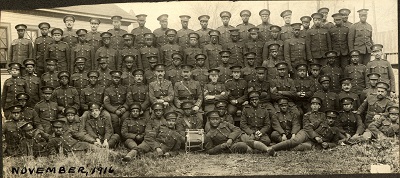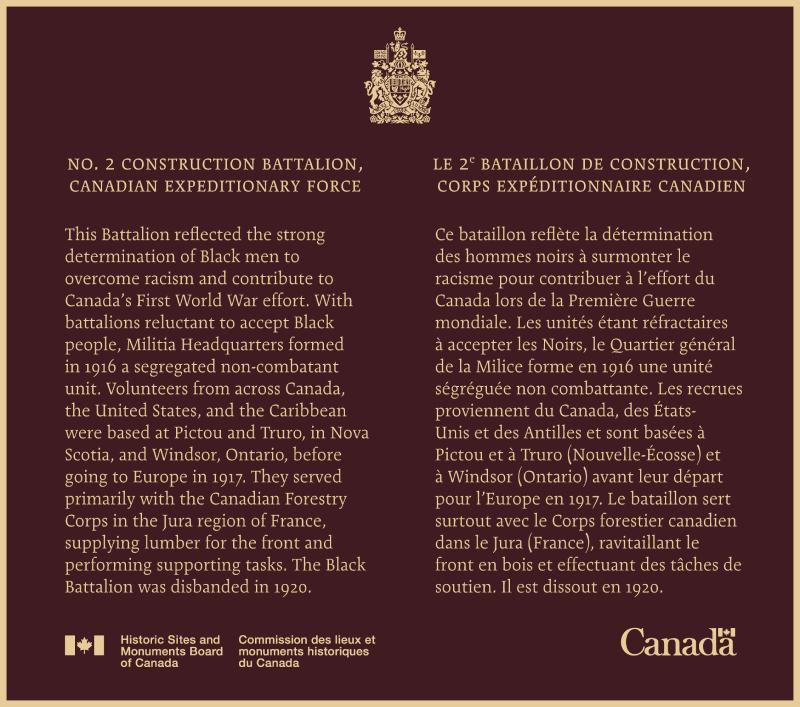Nº 2 Construction Battalion, C. E. F. National Historic Event

© Museum Windsor, P6110

© City of Toronto Archives, Fonds 2, Series 411, Item 86
The Nº 2 Construction Battalion, C. E. F. was designated a national historic event in 1992.
Historical importance: Reflects the strong determination of Black men to overcome racism and contribute to Canada’s First World War effort.
Commemorative plaque: On Caladh Avenue by Market Street, Pictou, Nova Scotia Footnote 1
This Battalion reflected the strong determination of Black men to overcome racism and contribute to Canada’s First World War effort. With battalions reluctant to accept Black people, Militia Headquarters formed in 1916 a segregated non-combatant unit. Volunteers from across Canada, the United States, and the Caribbean were based at Pictou and Truro, in Nova Scotia, and Windsor, Ontario, before going to Europe in 1917. They served primarily with the Canadian Forestry Corps in the Jura region of France, supplying lumber for the front and performing supporting tasks. The Black Battalion was disbanded in 1920.
No. 2 Construction Battalion, C.E.F.
This segregated non-combat battalion served with the Canadian Expeditionary Force (CEF) during the First World War.

© Parks Canada
Many people of African descent volunteered to serve in the military after Canada entered the First World War in 1914, but while some were able to enlist, others were turned away because of racist assumptions that they were unfit to serve. It took ongoing pressure by the African Canadian community to help force a change. Rather than integrating African Canadians into existing units, the Department of Defence and Militia authorised the formation of the No. 2 Construction Battalion on 5 July 1916 under the command of Lieutenant-Colonel Daniel H. Sutherland, an officer of European descent from Nova Scotia. Arthur Nelson Ware and William James Ware of Calgary, sons of the famous cowboy John Ware, were among the many men who travelled from across Canada to join the No. 2 Construction Battalion. Others came from the United States and the Caribbean.
The No. 2 Construction Battalion arrived in England in early April 1917. The following month, the renamed No. 2 Construction Company (as it had never reached full battalion strength) made its way to the Jura region of France, near the Swiss border. There, the men became part of the Canadian Forestry Corps, supplying lumber for the front and providing essential support services, often under enemy fire. For example, they oversaw the transportation of logs to the mills, then the finished product to railroad conjunctions. The wood was then shipped out for use as railway ties, and board and stakes for trenches. The battalion was also charged with supervising a station that supplied more than 1,300 men with the water they needed for cooking, drinking, and washing. This was hard work: the weather and the terrain made mechanized operations difficult, the horses they received were considered Category “B” animals (already in poor condition), water lines often leaked, and pumps had to move water up a rise of 1,500 feet. In addition, the men continued to be subjected to racial discrimination and harassment.

In November 1917, an officer and roughly 50 other ranks from the No. 2 Construction Company were attached to No. 37 Company, Canadian Forestry Corps near Peronne in northern France, coming within close range of advancing German forces during the Spring Offensive of 1918. The No. 2 Construction Company was among the first to be demobilized and sent back to Canada after the war ended with the Allied victory in November.
Backgrounder last update: 2022-06-14
The National Program of Historical Commemoration relies on the participation of Canadians in the identification of places, events and persons of national historic significance. Any member of the public can nominate a topic for consideration by the Historic Sites and Monuments Board of Canada.
- Date modified :